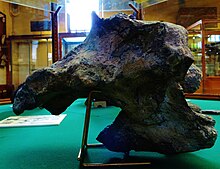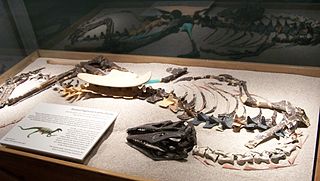
Coeluridae is a historically unnatural group of generally small, carnivorous dinosaurs from the late Jurassic Period. For many years, any small Jurassic or Cretaceous theropod that did not belong to one of the more specialized families recognized at the time was classified with the coelurids, creating a confusing array of 'coelurid' theropods that were not closely related. Although they have been traditionally included in this family, there is no evidence that any of these primitive coelurosaurs form a natural group with Coelurus, the namesake of Coeluridae, to the exclusion of other traditional coelurosaur groups.

Carnosauria is an extinct group of carnivorous theropod dinosaurs that lived during the Jurassic and Cretaceous periods.
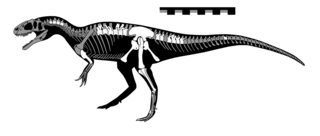
Gasosaurus is a genus of tetanuran theropod that lived approximately 171.6 to 161.2 million years ago during the middle of the Jurassic Period. The name "Gasosaurus" is derived from the English "gasoline" and the Greek σαῦρος. Only one species is currently recognised, G. constructus, from which the specific name honours the gasoline company that found the Dashanpu fossil quarry in Sichuan Province, China, now named as the Lower Shaximiao Formation.

Afrovenator is a genus of megalosaurid theropod dinosaur from the Middle or Late Jurassic Period on the Tiourarén Formation and maybe the Irhazer II Formation of the Niger Sahara region in northern Africa. Afrovenator represents the only properly identified Gondwanan megalosaur, with proposed material of the group present in the Late Jurassic on Tacuarembó Formation of Uruguay and the Tendaguru Formation of Tanzania.
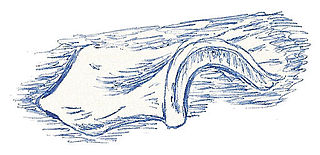
Iliosuchus is a genus of theropod dinosaur known from Bathonian–age rocks of England. It was perhaps 2 metres (6.6 ft) long.
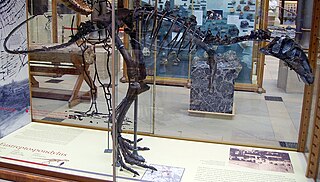
Eustreptospondylus is a genus of megalosaurid theropod dinosaur, from the Oxfordian stage of the Late Jurassic period in southern England, at a time when Europe was a series of scattered islands.

Piatnitzkysaurus is a genus of megalosauroid theropod dinosaur that lived approximately 179 to 177 million years ago during the lower part of the Jurassic Period in what is now Argentina. Piatnitzkysaurus was a moderately large, lightly built, bipedal, ground-dwelling carnivore that could grow up to 6.6 m (21.7 ft) long.

Siamotyrannus is a genus of theropod dinosaur from the early Cretaceous of Thailand.

Megalosauroidea is a superfamily of tetanuran theropod dinosaurs that lived from the Middle Jurassic to the Late Cretaceous period. The group is defined as Megalosaurus bucklandii and all taxa sharing a more recent common ancestor with it than with Allosaurus fragilis or Passer domesticus. Members of the group include Spinosaurus, Megalosaurus, and Torvosaurus. They are possibly paraphyletic in nature with respect to Allosauroidea.

Magnosaurus was a genus of theropod dinosaur from the Middle Jurassic of England. It is based on fragmentary remains and has often been confused with or included in Megalosaurus.
Chuandongocoelurus is a genus of carnivorous tetanuran theropod dinosaur from the Jurassic of China.

Szechuanosaurus is an extinct genus of carnivorous theropod dinosaur from the Late Jurassic. Fossils referred to the genus have been found in China, Asia in the Oxfordian-?Tithonian. Its type species is based on several undiagnostic teeth from the Kuangyuan Series. Additional possible specimens of Szechuanosaurus were also reported from the Kalaza Formation, also located in China.

Chienkosaurus is a dubious genus of carnivorous theropod dinosaur from the Late Jurassic Kuangyuan Series of China. It was probably related to Szechuanosaurus.

Dubreuillosaurus is a genus of carnivorous dinosaur from the middle Jurassic Period. It is a megalosaurid theropod. Its fossils were found in France. The only named species, Dubreuillosaurus valesdunensis, was originally described as a species of Poekilopleuron, Poekilopleuron? valesdunensis, which is still formally the type species of the genus. It was later renamed Dubreuillosaurus valesdunensis when, in 2005, Allain came to the conclusion that it was not part of the genus Poekilopleuron. Its type specimen, MNHN 1998-13, is only rivalled in the number of preserved elements in this group by that of Eustreptospondylus. Dubreuillosaurus is considered to be the sister species of Magnosaurus. It did not show signs of insular dwarfism even though it was uncovered on an island.

Kelmayisaurus is an extinct genus of carcharodontosaurid theropod dinosaur from the Early Cretaceous. It was roughly 10–12 meters long and its name refers to the petroleum-producing city of Karamay in the Xinjiang province of western China near where it was found.

Streptospondylus is a genus of tetanuran theropod dinosaur known from the Late Jurassic period of France, 161 million years ago. It was a medium-sized predator with an estimated length of 6 meters (19.5 ft) and a weight of 500 kg (1,100 lbs).

Allosauroidea is a superfamily or clade of theropod dinosaurs which contains four families — the Metriacanthosauridae, Allosauridae, Carcharodontosauridae, and Neovenatoridae. Allosauroids, alongside the family Megalosauroidea, were among the apex predators that were active during the Middle Jurassic to Late Cretaceous periods. The most famous and best understood allosauroid is the North American genus Allosaurus.
Thomas Richard Holtz Jr. is an American vertebrate palaeontologist, author, and principal lecturer at the University of Maryland's Department of Geology. He has published extensively on the phylogeny, morphology, ecomorphology, and locomotion of terrestrial predators, especially on tyrannosaurids and other theropod dinosaurs. He wrote the book Dinosaurs and is the author or co-author of the chapters "Saurischia", "Basal Tetanurae", and "Tyrannosauroidea" in the second edition of The Dinosauria. He has also been consulted as a scientific advisor for the Walking with Dinosaurs BBC series as well as the Discovery special When Dinosaurs Roamed America, and has appeared in numerous documentaries focused on prehistoric life, such as Jurassic Fight Club on History and Monsters Resurrected, Dinosaur Revolution and Clash of the Dinosaurs on Discovery.

Duriavenator is a genus of theropod dinosaur that lived in what is now England during the Middle Jurassic, about 168 million years ago. In 1882, upper and lower jaw bones of a dinosaur were collected near Sherborne in Dorset, and Richard Owen considered the fossils to belong to the species Megalosaurus bucklandii, the first named non-bird dinosaur. By 1964, the specimen was recognised as belonging to a different species, and in 1974 it was described as a new species of Megalosaurus, M. hesperis; the specific name means 'the West' or 'western'. Later researchers questioned whether the species belonged to Megalosaurus, in which many fragmentary theropods from around the world had historically been placed. After examining the taxonomic issues surrounding Megalosaurus, Roger B. J. Benson moved M. hesperis to its own genus in 2008, Duriavenator; this name means "Dorset hunter".
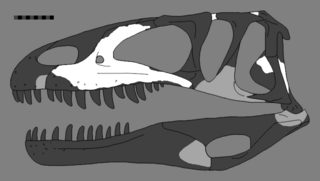
Leshansaurus is a genus of theropod dinosaur from the Late Jurassic Shaximiao Formation of what is now China. It was described in 2009 by a team of Chinese paleontologists. The type species is Leshansaurus qianweiensis. Fossils of Leshansaurus were discovered in strata from the Shangshaximiao Formation, a formation rich in dinosaur fossils. Li et al. referred this taxon to Sinraptoridae – a group of carnosaurian theropods, but it may belong to Megalosauridae instead.

